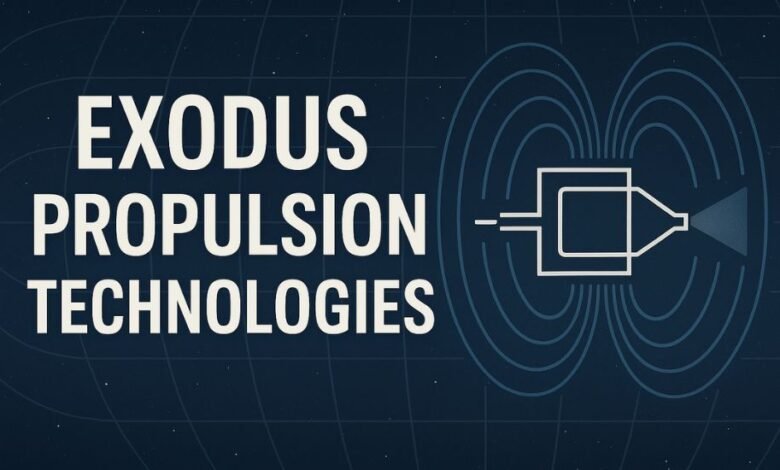Exodus Propulsion Technologies: Explained and Debunked

Throughout history, space exploration has been driven by innovations in propulsion technology. Rockets powered by chemical propellants carried humans to the Moon, ion thrusters have propelled satellites across the solar system, and nuclear concepts are being studied for faster interplanetary travel. Now, a company named Exodus Propulsion Technologies has entered the conversation with a bold claim: a propellantless propulsion system that challenges the very foundations of physics.
This article explores the background of Exodus Propulsion Technologies, how their system allegedly works, the skepticism surrounding their claims, and how it compares to NASA’s current propulsion advancements.
What is Exodus Propulsion Technologies?
Exodus Propulsion Technologies is a Florida-based aerospace startup founded by Dr. Charles Buhler, a veteran engineer with experience in NASA projects. The company’s central claim is that it has developed a propulsion system that generates thrust using electrostatic fields without the need for traditional propellant.
Their patented system is often referred to as the “Exodus Effect.” Unlike conventional rockets that expel gas or ions to move, this technology allegedly produces thrust by manipulating electric fields, resulting in continuous acceleration without fuel.
The idea, if proven true, could revolutionize space travel by drastically reducing mass, cost, and complexity in spacecraft design.
What is Exodus and How Does it Work?
The company asserts that the Exodus system works through electrostatic pressure. By arranging electrodes in specific configurations, strong electric fields are created that, according to their claims, generate a persistent net force.
Traditional physics insists that in a closed system, all forces cancel unless mass is expelled to conserve momentum. Exodus, however, suggests that it has identified a previously overlooked effect that allows thrust generation without propellant ejection.
Although the idea has sparked excitement in some circles, the broader scientific community remains cautious. Without peer-reviewed validation and independent replication, Exodus’s approach is still considered speculative.
How Does Exodus Propulsion Work?
From public explanations, Exodus propulsion is based on electrostatic field interactions. Instead of heating chemicals or ionizing fuel, the system uses electricity alone to generate thrust.
-
Conventional electric propulsion works by ionizing a gas such as xenon and expelling it at high speed, which provides thrust while conserving momentum.
-
Exodus propulsion claims to bypass the need for any expelled propellant, relying solely on electric field pressure.
If accurate, the technology could provide limitless propulsion as long as electrical power is available. However, critics argue that the claim contradicts Newton’s third law of motion, raising doubts about its physical validity.
Scientific Skepticism
The space science community has seen similar claims in the past, such as the infamous “EM Drive,” which was widely discussed but ultimately failed independent testing.
Critics emphasize that:
-
Momentum must be conserved. Any propulsion system must exchange momentum with something—propellant, photons, or the surrounding medium.
-
Experimental error is common. Electrostatic devices are notoriously difficult to measure accurately due to interference, vibration, and thermal drift.
-
Independent replication is essential. Until multiple laboratories reproduce the results under controlled conditions, claims of “reactionless thrust” will remain unproven.
For Exodus to be taken seriously in the long run, it must conduct transparent, space-based experiments and submit results to rigorous scientific review.
Is Exodus Propulsion Technologies a Stock Symbol?
No, Exodus Propulsion Technologies is not a publicly traded company. It is a privately held startup and does not have a stock symbol.
Investors should note that there is another company called Exodus Movement, Inc., which deals with cryptocurrency wallets and trades under the ticker EXOD. This firm has no relation to Exodus Propulsion Technologies.
What Are the Three Types of Propulsion?
When classifying propulsion systems used in spaceflight, three main categories are typically identified:
-
Chemical Propulsion
-
Uses chemical reactions to generate thrust.
-
Provides high thrust but consumes large amounts of propellant.
-
Used in rockets for launch and deep-space maneuvers.
-
-
Electric Propulsion
-
Uses electrical energy to accelerate propellant such as xenon ions.
-
Extremely fuel-efficient, but produces low thrust.
-
Widely used for satellites and long-duration missions.
-
-
Nuclear Propulsion
-
Uses nuclear reactors either to heat propellant (nuclear thermal) or generate electricity (nuclear electric).
-
Promises higher efficiency and speed for interplanetary travel.
-
Alongside these, propellantless but not reactionless methods exist, such as solar sails and electrodynamic tethers, which exchange momentum with photons or plasma.
NASA’s New Propulsion Systems
While Exodus Propulsion Technologies pursues its controversial ideas, NASA continues to advance propulsion along established, proven lines. Two major technologies stand out:
-
Advanced Electric Propulsion System (AEPS)
-
A next-generation Hall-effect thruster capable of operating at 12–13 kilowatts per unit.
-
Will be used on the Lunar Gateway’s Power and Propulsion Element to support deep-space missions.
-
Provides high efficiency for long-duration operations.
-
-
Nuclear Thermal Propulsion (NTP)
-
Uses a fission reactor to heat hydrogen propellant and expel it for thrust.
-
Offers roughly twice the efficiency of chemical rockets.
-
Currently being developed under the DRACO program (Demonstration Rocket for Agile Cislunar Operations) with test missions expected before the end of the decade.
-
These technologies represent NASA’s near-term path for advancing human space exploration.
Comparing Exodus to NASA’s Roadmap
-
Exodus Propulsion: Claims a breakthrough in reactionless thrust but remains unproven. Its future depends on rigorous testing and independent validation.
-
NASA Propulsion: Focuses on scalable, proven technologies like electric propulsion and nuclear thermal propulsion that are grounded in physics and already undergoing qualification for spaceflight.
The comparison highlights the difference between bold, unverified claims and practical, tested solutions.
What Would Prove Exodus Right?
For Exodus Propulsion Technologies to gain acceptance, it would need to demonstrate:
-
Independent laboratory replication under controlled conditions.
-
On-orbit demonstration of a spacecraft propelled solely by their device.
-
Peer-reviewed publications explaining the underlying physics.
-
Transparent data sharing to address concerns of experimental error.
Until then, the technology will remain in the realm of speculation.
Potential Impact if Real
If Exodus propulsion technology proves to be real and scalable, the implications are enormous:
-
Space travel without fuel depots: Missions could travel farther without carrying heavy propellant.
-
Longer spacecraft lifespans: Unlimited maneuverability with only electrical power required.
-
Cost reductions: Lower launch mass means cheaper missions.
-
New mission profiles: Deep-space exploration and interstellar probes could become feasible.
However, even if validated, challenges like power generation, spacecraft integration, and electromagnetic safety would still need to be solved.
Conclusion
Exodus Propulsion Technologies has captured attention with its claim of a propellantless drive using electrostatic fields. If real, the technology could transform space exploration, but extraordinary claims require extraordinary evidence. At present, there is no independent proof that such propulsion works as advertised.
Meanwhile, NASA’s path forward is clear, focusing on electric propulsion for near-term missions and nuclear propulsion for interplanetary travel. These systems are grounded in tested physics and are already on the path to spaceflight.
For now, Exodus remains a fascinating story in the ongoing quest to push humanity further into space—but one that must still prove itself.
Article prepared by News Zio



